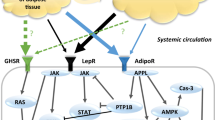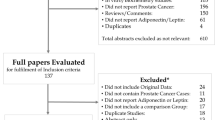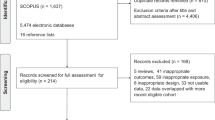Abstract
The prevalence of both obesity and prostate cancer are increasing in the US. Recently, there has been keen interest in the relationship between obesity and the biology of cancers, including prostate cancer. This article reviews the current literature regarding body mass index (BMI) and its relationship with various clinical aspects of prostate cancer, including its incidence, screening, diagnosis and treatment. Despite several biological mechanisms that potentially link obesity to prostate cancer, the effects of obesity on serum PSA levels and prostate volume, and the subsequent effects on the detection of prostate cancer, are not consistent according to the available literature. Additionally, the epidemiologic data for the incidence of prostate cancer in obese and non-obese populations are conflicting. Treatment of prostate cancer in obese populations is problematic, but data on the ability to overcome these difficulties are unclear. It is difficult to determine whether oncologic and functional outcomes in obese patients differ substantially from those in non-obese patients. Separating the contributions of technical issues from potentially different tumor biologies is not currently possible. Hopefully, the increasing focus on these two highly prevalent health problems might further elucidate their complex relationship.
Key Points
-
PSA levels seem to decrease with increasing BMI in men without evidence of prostate cancer
-
Epidemiologic studies to date do not show a clear association between obesity and the incidence of prostate cancer
-
Obesity seems to increase the risk of biochemical recurrence after radical prostatectomy
-
Despite technical difficulties in treating obese patients, surgical treatment of prostate cancer in obese men seems feasible and results in similar functional outcomes to those in non-obese patients
-
Obese patients might have worse urinary function after radical prostatectomy compared with non-obese patients
This is a preview of subscription content, access via your institution
Access options
Subscribe to this journal
Receive 12 print issues and online access
$209.00 per year
only $17.42 per issue
Buy this article
- Purchase on Springer Link
- Instant access to full article PDF
Prices may be subject to local taxes which are calculated during checkout
Similar content being viewed by others
References
Ogden CL et al. (2006) Prevalence of overweight and obesity in the United States, 1999–2004. JAMA 295: 1549–1555
Jemal A et al. (2007) Cancer statistics, 2007. CA Cancer J Clin 57: 43–66
Calle EE et al. (2003) Overweight, obesity, and mortality from cancer in a prospectively studied cohort of U.S. adults. N Engl J Med 348: 1625–1638
Baillargeon J et al. (2005) The association of body mass index and prostate-specific antigen in a population-based study. Cancer 103: 1092–1095
Fowke JH et al. (2006) Effects of obesity and height on prostate-specific antigen (PSA) and percentage of free PSA levels among African-American and Caucasian men. Cancer 107: 2361–2367
Loeb S et al. (2007) Does body mass index affect preoperative prostate specific antigen velocity or pathological outcomes after radical prostatectomy? J Urol 177: 102–106
D'Amico AV et al. (2004) Preoperative PSA velocity and the risk of death from prostate cancer after radical prostatectomy. N Engl J Med 351: 125–135
Freedland SJ et al. (2006) Obesity, serum prostate specific antigen and prostate size: implications for prostate cancer detection. J Urol 175: 500–504
Bosch JL et al. (1995) Prostate specific antigen in a community-based sample of men without prostate cancer: correlations with prostate volume, age, body mass index, and symptoms of prostatism. Prostate 27: 241–249
Hutterer G et al. (2007) Body mass index does not predict prostate-specific antigen or percent free prostate-specific antigen in men undergoing prostate cancer screening. Eur J Cancer 43: 1180–1187
Kristal AR et al. (2006) Associations of demographic and lifestyle characteristics with prostate-specific antigen (PSA) concentration and rate of PSA increase. Cancer 106: 320–328
Ku JH et al. (2003) Influence of age, anthropometry, and hepatic and renal function on serum prostate-specific antigen levels in healthy middle-age men. Urology 61: 132–136
Dahle SE et al. (2002) Body size and serum levels of insulin and leptin in relation to the risk of benign prostatic hyperplasia. J Urol 168: 599–604
Hammarsten J and Högstedt B (2001) Hyperinsulinaemia as a risk factor for developing benign prostatic hyperplasia. Eur Urol 39: 151–158
Putnam SD et al. (2000) Lifestyle and anthropometric risk factors for prostate cancer in a cohort of Iowa men. Ann Epidemiol 10: 361–369
Andersson SO et al. (1997) Body size and prostate cancer: a 20-year follow-up study among 135,006 Swedish construction workers. J Natl Cancer Inst 89: 385–389
Engeland A et al. (2003) Height, body mass index, and prostate cancer: a follow-up of 950,000 Norwegian men. Br J Cancer 89: 1237–1242
Giovannucci E et al. (1997) Height, body weight, and risk of prostate cancer. Cancer Epidemiol Biomarkers Prev 6: 557–563
Nilsen TI and Vatten LJ (1999) Anthropometry and prostate cancer risk: a prospective study of 22,248 Norwegian men. Cancer Causes Control 10: 269–275
Schuurman AG et al. (2000) Anthropometry in relation to prostate cancer risk in the Netherlands Cohort Study. Am J Epidemiol 151: 541–549
Hubbard JS et al. (2004) Association of prostate cancer risk with insulin, glucose, and anthropometry in the Baltimore longitudinal study of aging. Urology 63: 253–258
Clarke G and Whittemore AS (2000) Prostate cancer risk in relation to anthropometry and physical activity: the National Health and Nutrition Examination Survey I Epidemiological Follow-Up Study. Cancer Epidemiol Biomarkers Prev 9: 875–881
MacInnis RJ and English DR (2006) Body size and composition and prostate cancer risk: systematic review and meta-regression analysis. Cancer Causes Control 17: 989–1003
Wright ME et al. (2007) Prospective study of adiposity and weight change in relation to prostate cancer incidence and mortality. Cancer 109: 675–684
Gong Z et al. (2006) Obesity, diabetes, and risk of prostate cancer: results from the prostate cancer prevention trial. Cancer Epidemiol Biomarkers Prev 15: 1977–1983
Rodriguez C et al. (2007) Body mass index, weight change, and risk of prostate cancer in the Cancer Prevention Study II Nutrition Cohort. Cancer Epidemiol Biomarkers Prev 16: 63–69
Freedland SJ and Platz EA (2007) Obesity and prostate cancer: making sense out of apparently conflicting data. Epidemiol Rev 29: 88–97
Dal Maso L et al. (2004) Prostate cancer and body size at different ages: an Italian multicentre case–control study. Br J Cancer 90: 2176–2180
Robinson WR et al. (2005) Obesity before age 30 years and risk of advanced prostate cancer. Am J Epidemiol 161: 1107–1114
Fontaine KR et al. (2005) Obesity and prostate cancer screening in the USA. Public Health 119: 694–698
Barqawi AB et al. (2005) Observed effect of age and body mass index on total and complexed PSA: analysis from a national screening program. Urology 65: 708–712
Werny DM et al. (2007) Obesity is negatively associated with prostate-specific antigen in U.S. men, 2001–2004. Cancer Epidemiol Biomarkers Prev 16: 70–76
Karakiewicz PI et al. (1997) Outcome of sextant biopsy according to gland volume. Urology 49: 55–59
Anast JW et al. (2005) The impact of obesity on health related quality of life before and after radical prostatectomy (data from CaPSURE). J Urol 173: 1132–1138
Freedland SJ et al. (2005) Obesity does not adversely affect health-related quality-of-life outcomes after anatomic retropubic radical prostatectomy. Urology 65: 1131–1136
Litwin MS et al. (1998) The UCLA Prostate Cancer Index: development, reliability, and validity of a health-related quality of life measure. Med Care 36: 1002–1012
Montgomery JS et al. (2006) Obesity adversely affects health related quality of life before and after radical retropubic prostatectomy. J Urol 176: 257–261
Ahlering TE et al. (2005) Impact of obesity on clinical outcomes in robotic prostatectomy. Urology 65: 740–744
Freedland SJ et al. (2004) Impact of obesity on biochemical control after radical prostatectomy for clinically localized prostate cancer: a report by the Shared Equal Access Regional Cancer Hospital database study group. J Clin Oncol 22: 446–453
Freedland SJ et al. (2005) Obesity and capsular incision at the time of open retropubic radical prostatectomy. J Urol 174: 1798–1801
Amling CL et al. (2004) Pathologic variables and recurrence rates as related to obesity and race in men with prostate cancer undergoing radical prostatectomy. J Clin Oncol 22: 439–445
Chang SS et al. (2004) Predicting blood loss and transfusion requirements during radical prostatectomy: the significant negative impact of increasing body mass index. J Urol 171: 1861–1865
Hsu EI et al. (2003) Influence of body weight and prostate volume on intraoperative, perioperative, and postoperative outcomes after radical retropubic prostatectomy. Urology 61: 601–606
Yang BK et al. (2006) Radical perineal prostatectomy for treatment of localized prostate cancer in obese and nonobese patients: a matched control study. Urology 67: 990–995
Dahm P et al. (2005) Radical perineal prostatectomy for the treatment of localized prostate cancer in morbidly obese patients. J Urol 174: 131–134
Eden CG et al. (2006) The impact of obesity on laparoscopic radical prostatectomy. BJU Int 98: 1279–1282
Brown JA et al. (2005) Laparoscopic radical prostatectomy and body mass index: an assessment of 151 sequential cases. J Urol 173: 442–445
El-Feel A et al. (2003) Laparoscopic radical prostatectomy—an analysis of factors affecting operating time. Urology 62: 314–318
Singh A et al. (2005) Impact of prostate size and body mass index on perioperative morbidity after laparoscopic radical prostatectomy. J Urol 173: 552–554
Bhayani SB et al. (2004) Laparoscopic radical prostatectomy: a multi-institutional study of conversion to open surgery. Urology 63: 99–102
Mikhail AA et al. (2006) Robotic-assisted laparoscopic prostatectomy in overweight and obese patients. Urology 67: 774–779
Khaira HS et al. (2006) Does obesity influence the operative course or complications of robot-assisted laparoscopic prostatectomy. BJU Int 98: 1275–12788; discussion, 1278
Amling CL et al. (2001) Relationship between obesity and race in predicting adverse pathologic variables in patients undergoing radical prostatectomy. Urology 58: 723–728
Rohrmann S et al. (2003) Family history of prostate cancer and obesity in relation to high-grade disease and extraprostatic extension in young men with prostate cancer. Prostate 55: 140–146
Mydlo JH et al. (2001) A pilot study analyzing PSA, serum testosterone, lipid profile, body mass index and race in a small sample of patients with and without carcinoma of the prostate. Prostate Cancer Prostatic Dis 4: 101–105
Mallah KN et al. (2005) Body mass index is weakly associated with, and not a helpful predictor of, disease progression in men with clinically localized prostate carcinoma treated with radical prostatectomy. Cancer 103: 2030–2034
Neugut AI et al. (2004) The 'skinny' on obesity and prostate cancer prognosis. J Clin Oncol 22: 395–398
Rockhill J et al. (2002) Prostate brachytherapy in obese patients. Brachytherapy 1: 54–60
Merrick GS et al. (2005) Influence of body mass index on biochemical outcome after permanent prostate brachytherapy. Urology 65: 95–100
Strom SS et al. (2006) Influence of obesity on biochemical and clinical failure after external-beam radiotherapy for localized prostate cancer. Cancer 107: 631–639
Author information
Authors and Affiliations
Corresponding author
Ethics declarations
Competing interests
The authors declare no competing financial interests.
Rights and permissions
About this article
Cite this article
Skolarus, T., Wolin, K. & Grubb, R. The effect of body mass index on PSA levels and the development, screening and treatment of prostate cancer. Nat Rev Urol 4, 605–614 (2007). https://doi.org/10.1038/ncpuro0944
Received:
Accepted:
Issue Date:
DOI: https://doi.org/10.1038/ncpuro0944
This article is cited by
-
Serum gonadotropins, cortisol, PSA, and micronutrient levels among men with prostate carcinoma
African Journal of Urology (2021)
-
Body size throughout the life-course and incident benign prostatic hyperplasia-related outcomes and nocturia
BMC Urology (2021)
-
Systematic review and meta-analysis of the associations between body mass index, prostate cancer, advanced prostate cancer, and prostate-specific antigen
Cancer Causes & Control (2020)
-
Obese men have more advanced and more aggressive prostate cancer at time of surgery than non-obese men after adjusting for screening PSA level and age: results from two independent nested case–control studies
Prostate Cancer and Prostatic Diseases (2013)
-
Design and analysis issues in gene and environment studies
Environmental Health (2012)



